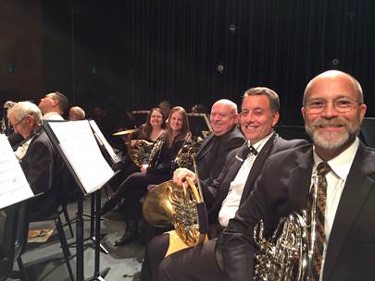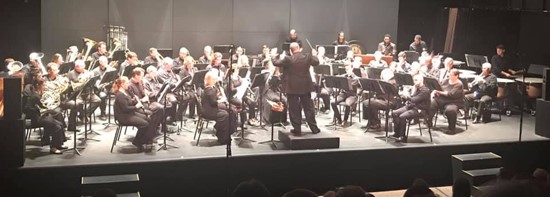College of Engineering News Room
Engineers Defy a Stereotype with Music
By Brad Stager
With a well-deserved reputation for precision, engineers are often portrayed in fiction or characterized in daily conversation as too quantitatively oriented for creative endeavors like performing or creating music.
There are plenty of examples that suggest otherwise, such as Tom Scholz, who earned a bachelor's degree and a master's degree in mechanical engineering from the Massachusetts Institute of Technology. Scholz, known for playing guitar, bass, and keyboards, then worked as a senior product designer for the Polaroid Corporation before moving to Boston and achieving rock 'n' roll fame by starting the band named after the city.
Recordings by Boston are a staple of classic rock playlists, a genre that’s popular with many of the faculty and staff of the College of Engineering, including Dean Robert Bishop, who shared his appreciation for music and the legendary English rock band Free, as well as its following incarnation as Bad Company via an Operation: Engineering, How Are You Doing? email.
“Music has always been a part of my life,” wrote Bishop, who plays the guitar. “My father was a big bands/jazz musician playing saxophone and clarinet.”
French horn player Robert Bertini, who is the director of the Center for Urban Transportation Research at USF, says that music has been an important activity for most of his life, delivering “a lot of peace, joy, fun and friendships.”
“While playing in a group you can’t think about anything else, so it is a healthy form of concentration and even meditation in a way,” Bertini said.
He added that he would like to form a brass quintet with trumpet, trombone and tuba players who share an interest in performing with other musicians.

Currently Bertini performs with Fanfare Concert Winds, a concert band in Tampa with dozens of professional and amateur musicians, including Bertini’s colleague at CUTR — Kristin Larsson.
Larsson has been playing clarinet for 30 years and extends an invitation for people to hear Fanfare Concert Winds.
“We’re not playing together right now due to the current circumstances, but once we do start back up, it would be great to have some COE folks come out for a concert,” she said.
For now, you can check out Fanfare Concert Winds on video via the group’s Facebook page, Fanfare Concert Winds - Tampa, and its website fanfareconcertwinds.org.

As a graphic designer for CUTR, David Fink is known for expressing his creativity visually by creating content that illustrates the work performed for USF. He says his hands are as comfortable manipulating drumsticks as they are with a pen, pencil, alabaster, chisel or keyboard.
"Music and drumming has been part of my spirit and soul for most of my life,” Fink said. “What a great universal language ... a perfect way to stretch both sides of our brains right now. Find an instrument that you put in the closet years ago and express yourself with it.”
For some of the College’s musicians, taking up an instrument has opened up opportunities to travel and meet people who they otherwise wouldn’t, such as violinist and administrator Veronica Jo’s experience with a special performance to an appreciative audience.
“I’ve been playing the violin for 37 years,” Jo said. “About 25 years ago, my violin ensemble was invited to the Vatican for a private performance with Pope John Paul II.”
“Music has always been one form of release for me – a way to reflect, connect, and express myself and my emotions,” she said. “Music has kept me both grounded and lifted to new levels all at the same time, which is probably also one of the many reasons why that performance with the Pope is so special to me.”

The violin is a popular instrument around the College, and in the hands of electrical engineering Professor Emeritus Dave Snider it has been repurposed for bluegrass fiddling at the highest level.
“I am a classically trained violinist and have played in a couple of minor symphony orchestras,” Snider said. “I never dared to attempt bluegrass, because it requires improvisation - a taboo in classical music. But about 15 years ago I was goaded into it by a one-armed (!) fiddler in North Carolina (he played with a prosthesis), and I was hooked.”
Snider adds that he lectures on music’s common denominator as well.
“One of my engineering society after-dinner talks is about the mathematics of tuning,” he said.
Snider is also the reigning Florida Cracker Museum and Longbeach (CA) Bluegrass Association fiddle champion and performs with the Million Dollar Quartet.
Jason Jackman of CUTR started out playing trombone in the school band and moved on to playing bass in a touring rock band for almost a decade around the turn of the century. Just about any combination of guitars and percussion that lies between the Beach Boys and Iron Maiden is of musical influence to the research associate.
“Many of the bands I listened to growing up told stories through their song lyrics and created new instrument sounds that would lay groundwork for future musicians,” Jackman said.
He suggests listening to the new band Fake Names. Online music platforms like Spotify, Pandora, and Youtube has helped him discover new music he would otherwise not have had access to.
You can also hear something new by chemical and biomedical engineering Professor Scott Campbell, who composes and records his own music on his YouTube channel swcampbell.
“I've long been interested in songwriting and it is difficult to get others to record your songs, so I learned enough to produce them myself,” Campbell said. “I play guitar and harmonica passably well, am a novice on the keys, banjo and bass, and about to learn the mandolin. My favorite music is folk, rock and folk-rock, with a 60s/70s vibe.”
With research interests and expertise in the areas of biomechanics and prosthetic design, how the human body interacts with musical instruments is something that may cross Professor William Lee III’s mind as he plays some of the string, keyboard and woodwind instruments he owns. A musician since starting “with piano lessons at age 6-7,” Lee is also interested in what goes on at the intersection of engineering and the arts.
“Music soothes the soul and actually complements the engineering stuff that I do as a professor, including my educational interests regarding how to nurture creativity,” he wrote in an email. “Engineering students (and faculty/staff): celebrate the arts! It is not an either/or, but rather a both/and.”

Lee has received a National Science Foundation grant in the area of engineering and arts interactions and is on the executive board of the University of South Florida’s Center for Music Education Research.
The connection between engineering and music may surprise a lot of people, but it is a valuable piece of insight to those who perceive it — and even promote it — as in the case of Stanford Engineering’s scholarship program known as Engineers in the Arts, which partially pays the cost for engineering students to continue their music studies while at Stanford University.
It is also known to Dean Bishop, who has provided a platform for the College’s creativity in his Operation: emails and videos.
“We are very creative, and we like art and music and I hope we are recognized for that,” he said. “People don’t think that about engineers, but in fact it is true.”